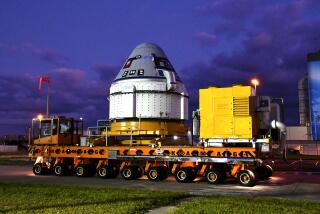Skies Clear for Space Station Shuttle Flight
- Share via
KENNEDY SPACE CENTER, Fla. — With the weather on both sides of the Atlantic vastly improving, a buoyant NASA pressed ahead Wednesday for a liftoff early today of its first space station construction flight.
All week, forecasters feared that clouds and rain might delay space shuttle Endeavour’s launch with the first American-built piece of the international space station.
But by Wednesday night, the rain had stopped and the full moon could be seen peeking from behind scattering clouds as NASA began fueling the shuttle.
Better weather also was expected at the prime emergency landing site in Spain. NASA will not launch unless at least one such site in Spain or Morocco is available.
Dignitaries from around the world gathered to see Endeavour and its crew of six off after a year’s delay caused by a cash crunch in Russia, NASA’s chief partner in the space station. Most were representatives of the 16 countries participating in the effort, and the guest list included Secretary of State Madeleine Albright.
The mission promises to be one of the most difficult in space shuttle history.
Two weeks ago, the Russians put the first piece of the space station into orbit.
During Endeavour’s 12-day flight, the astronauts will use the shuttle robot arm to capture the Russian piece and attach it to the American component. Then two astronauts will perform three spacewalks to hook up all the electrical connections and cables between the two cylinders.
The U.S. piece, named Unity, is a connecting passageway. It is essentially an aluminum can with big holes where other chambers eventually will attach. It contains six miles of wiring and more than 50,000 mechanical pieces.
The Russian component, named Zarya, which means sunrise, contains the power and propulsion systems that will keep the station aloft until the Russians can launch a permanent control module.
In all, more than 100 components weighing 1 million pounds are to be launched over the next five years, requiring 45 U.S. and Russian flights.
More to Read
Sign up for Essential California
The most important California stories and recommendations in your inbox every morning.
You may occasionally receive promotional content from the Los Angeles Times.










